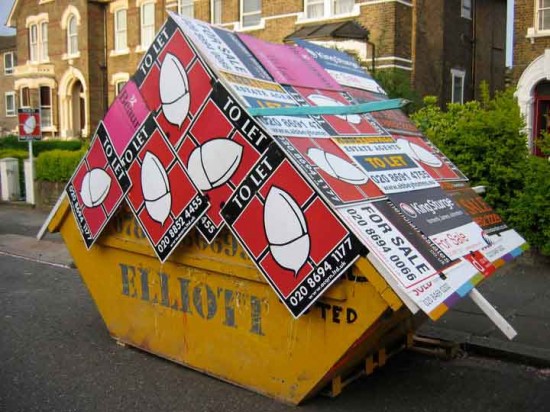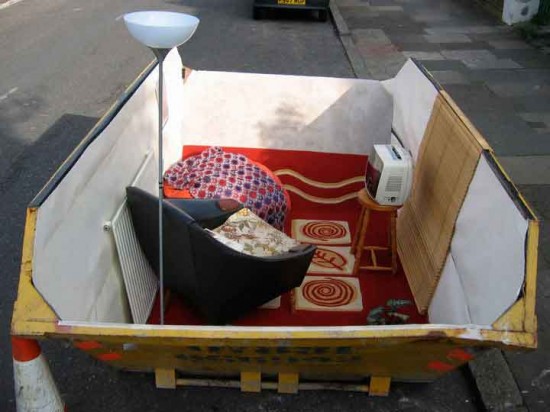BY OLIVER BISHOP YOUNG
I have always had an interest in what people throw away andwhere things end up. My foundation work culminated in sculptural treelike formsbuilt from magazines collected from our libraries bin.
As we generated 4,000 ideas on post-it notes at thebeginning of my final year at Goldsmiths the theme of exchange emerged as astrong fascination of mine. This was given a context when I saw a 1995 Ikeaadvert depicting a whole street throwing their ‘chintz’ furniture out and intoa skip. The image revealed the potential for a skip to become a point of bothmaterial and experiential exchange within the community. I then submergedmyself in the affairs of skips.
I designed a series of skip ‘add-ons’ to test and emphasisemy hypothesis. These included a blackboard that fits onto a skip. Using chalkpeople can note down what is added and removed from the skip, in turn providinga catalogue of materials available and aiding the re-use and exchange ofobjects. A plinth that sits on the edge of a skip provides a platform on whichthe most recent addition to the skip can be displayed with greateradvertisement. It can be shameful for some to be seen peering into askip, a convex mirror attachment makes it easy for people to see inside at aglance. While observing these ideas being tested, each day checking theblackboard’s changes: Added: Wheeley bin, vacuum cleaner, wood, love, curtainsbroken glass. Taken: MDF boards, the piss.
I developed an online digital version of a skip thatshares the materials and locations of physical skips across the country. Takingthe form of a website where you can upload your skip details for others to comeand collect or search yourself for materials and objects in skips in a specificarea. A demo version of the site can be veiwed at www.andrewhilton.net/oli/nav.php.
The latest part of my work has been exposingthe potential left in what people throw into skips and the architectural toolskips provide for claiming space in an urban environment. One way this was donewas by taking materials from skips (such as rubble and garden waste) andsetting them up as a garden in my own skip in front of my flat in Brockley, London.It created a new space for me to inhabit that balanced on the edge between myprivate home and public street. Over a couple of months I repeated thisformula, finding materials in skips such as wood, furniture and a bbq anddesigning an event formed around that material or object. The resultsemphasised the value left in the waste.
A skate ramp built in the skip from materials sourced fromskips brought in an element of play. It showed how the process could be used toprovide public spaces that are not present in the area. As demonstrated by mypark in a skip on Brick Lane for our degree exhibition. The idea was to bringsome much needed grass to the area and provide a space for the public to reston a reclaimed park bench as they visit the numerous Freerange exhibitions.
Other events included a swimming pool and BBQ area and thereare plans for future events in the capitol.
olly@oliverbishopyoung.co.uk
www.oliverbishopyoung.co.uk
















